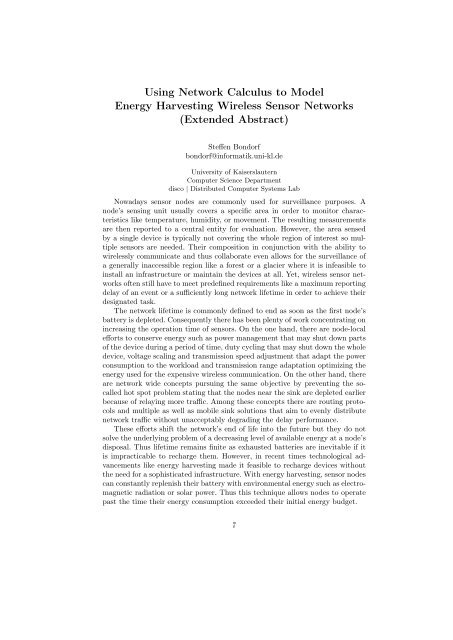MMB & DFT 2012 Workshop Proceedings
MMB & DFT 2012 Workshop Proceedings
MMB & DFT 2012 Workshop Proceedings
Create successful ePaper yourself
Turn your PDF publications into a flip-book with our unique Google optimized e-Paper software.
Using Network Calculus to ModelEnergy Harvesting Wireless Sensor Networks(Extended Abstract)Steffen Bondorfbondorf@informatik.uni-kl.deUniversity of KaiserslauternComputer Science Departmentdisco | Distributed Computer Systems LabNowadays sensor nodes are commonly used for surveillance purposes. Anode’s sensing unit usually covers a specific area in order to monitor characteristicslike temperature, humidity, or movement. The resulting measurementsare then reported to a central entity for evaluation. However, the area sensedby a single device is typically not covering the whole region of interest so multiplesensors are needed. Their composition in conjunction with the ability towirelessly communicate and thus collaborate even allows for the surveillance ofa generally inaccessible region like a forest or a glacier where it is infeasible toinstall an infrastructure or maintain the devices at all. Yet, wireless sensor networksoften still have to meet predefined requirements like a maximum reportingdelay of an event or a sufficiently long network lifetime in order to achieve theirdesignated task.The network lifetime is commonly defined to end as soon as the first node’sbattery is depleted. Consequently there has been plenty of work concentrating onincreasing the operation time of sensors. On the one hand, there are node-localefforts to conserve energy such as power management that may shut down partsof the device during a period of time, duty cycling that may shut down the wholedevice, voltage scaling and transmission speed adjustment that adapt the powerconsumption to the workload and transmission range adaptation optimizing theenergy used for the expensive wireless communication. On the other hand, thereare network wide concepts pursuing the same objective by preventing the socalledhot spot problem stating that the nodes near the sink are depleted earlierbecause of relaying more traffic. Among these concepts there are routing protocolsand multiple as well as mobile sink solutions that aim to evenly distributenetwork traffic without unacceptably degrading the delay performance.These efforts shift the network’s end of life into the future but they do notsolve the underlying problem of a decreasing level of available energy at a node’sdisposal. Thus lifetime remains finite as exhausted batteries are inevitable if itis impracticable to recharge them. However, in recent times technological advancementslike energy harvesting made it feasible to recharge devices withoutthe need for a sophisticated infrastructure. With energy harvesting, sensor nodescan constantly replenish their battery with environmental energy such as electromagneticradiation or solar power. Thus this technique allows nodes to operatepast the time their energy consumption exceeded their initial energy budget.7


